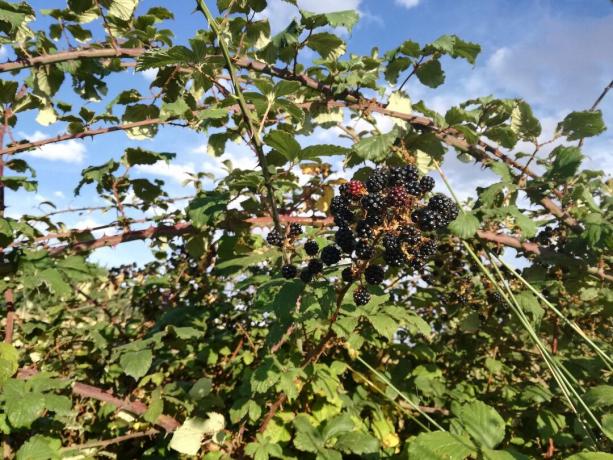The blackberry is an uncomplicated berry bush for the garden. We explain how you can successfully multiply the blackberry yourself.

the blackberry (Rubus fruticosus) is an often evergreen, prickly shrub that can be found growing wild along many roadsides. In gardens, the blackberry is mainly cultivated for its sweet, aromatic fruits, which can be harvested from June to October. Like most of our native fruits, the blackberry also belongs to the rose family (Rosaceae). It quickly grows over entire fences and climbing aids in the garden - a property that you can take advantage of when propagating.
contents
-
Multiply blackberries: These methods exist
- Propagate blackberries by runners
- Propagating blackberries by root cuttings
- Propagate blackberries by lowering
- Propagating blackberries by cuttings
- Propagating wild blackberries
- Caring for blackberries properly after propagation
Multiply blackberries: These methods exist
One blackberry bush is not enough for you? In this case, it is good to know how easy it is to propagate blackberry plants yourself using offshoots. There are several options for vegetative propagation. Upright growing
blackberry varieties is best propagated by root cuttings or runners. Climbing or creeping varieties can be propagated using sinkers, root cuttings or cuttings. Propagation via seeds is not of practical importance due to the high amount of work and time involved.Propagate blackberries by runners
Cultivated blackberry varieties usually multiply much less by themselves than their wild relatives. Nevertheless, it can lead to the formation of root suckers. The blackberry plant sprouts underground and emerges from the ground some distance away. If necessary, the new plant can be cut out with the longest possible root piece and planted in another place. The best time for this type of propagation is from October to April.
Propagating blackberries by root cuttings
Root cuttings are cut exclusively in late autumn. For this you use about 5 cm long root pieces, which have at least one or two shoot buds. These are placed in a box with moist potting soil and covered with a layer of soil about 2 cm deep. The seed box is placed in a light, cool and well-ventilated place over the winter. The young plants can be planted in a garden bed in spring, when the blackberries have formed shoots that are about 10 cm long.

Propagate blackberries by lowering
Many thornless varieties of blackberries, often incorrectly referred to as "thornless" blackberries, hardly ever sprout runners. If necessary, they can be increased by sinkers. For this purpose, long shoots of the blackberry plant are pressed to the ground about 30 to 50 cm below the tip of the shoot in April and covered with a layer of earth. To prevent the shoot from bending upwards again, it should be weighed down with a stone or piece of wood. This type of propagation is best done at the beginning of the growing season in spring. By autumn, the sinkers will form enough roots to be able to provide themselves with sufficient nutrients. The independent plant can then be separated from the mother plant.
Propagating blackberries by cuttings
The propagation of blackberries via offshoots is particularly suitable for obtaining larger quantities of plants. Cuttings are the cut off, non-lignified parts of a plant that are used for vegetative propagation. In early summer, annual shoots of the shrub are cut off and divided into pieces 5 to 10 cm long. Alternatively, you can only use the shoot tips, from which the head cuttings, which grow particularly well, can be pulled. In general, a blackberry cutting should have two to three nodes (leaf nodes) with healthy foliage. The cuttings are then placed in pots with a loose growing substrate - like the Plantura Organic Herb & Seed Soil - plugged. Ideal growth conditions prevail in a warm greenhouse with high humidity. If you don't have a greenhouse, you can cover the pots with cling film for the first four weeks.
However, when the first leaves appear, you should remove the foil - this allows the cuttings to acclimate well. Be sure to keep the soil moist at all times. When the cuttings have formed enough roots, they can be separated after about the sixth week. In a sheltered spot, the seedlings can get used to the outside climate until they are planted in September in the desired location.
This is how you proceed when propagating blackberries by cuttings:
- Cut annual shoots into pieces 5 to 10 cm long
- Put cuttings in potting soil
- Cover them with foil or moisten them regularly
- Remove foil after four weeks
- After sufficient rooting separate the cuttings
- Gradually get used to the outdoor climate and plant them out
Propagating wild blackberries
Wild blackberries usually settle themselves and reproduce without any human help. Accordingly, they can also be propagated relatively easily in the garden using roots or sinkers. However, the wild blackberry is extremely persistent. Under certain circumstances, it is therefore better to use thornless, non-proliferating cultivars. Because once you have the wild blackberry in the garden, it is very difficult to get rid of it. A containment with grids and curbs promises little success with the climbing plant. Here we explain how you proliferate Permanently remove blackberry plants be able.

Caring for blackberries properly after propagation
After successful propagation, the new blackberry plants can be planted out. In order to offer them the best possible starting aid, you should loosen the soil at the desired location and, if necessary, improve it with suitable fertilizers. Regular watering and fertilizing provides the plant with sufficient nutrients and water. After the first harvest at the latest, the two-year-old shoots should be cut back annually. Here we explain how to Pruning of the blackberry plant best to do.
When and how your Fertilize blackberries properly find out in this special article.

